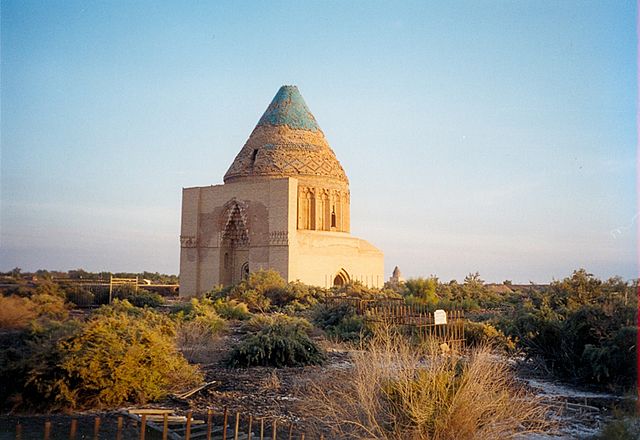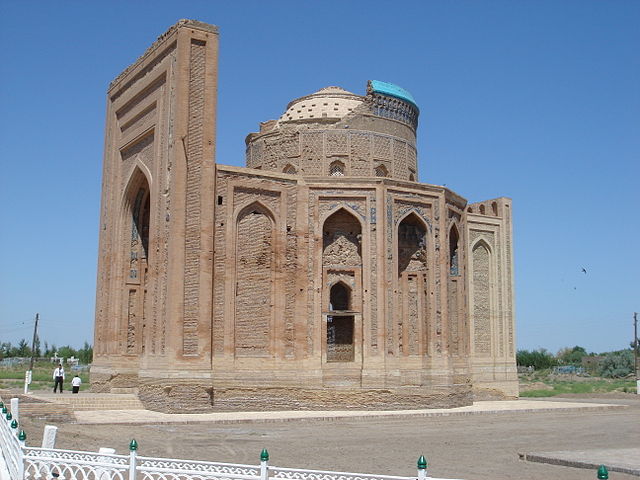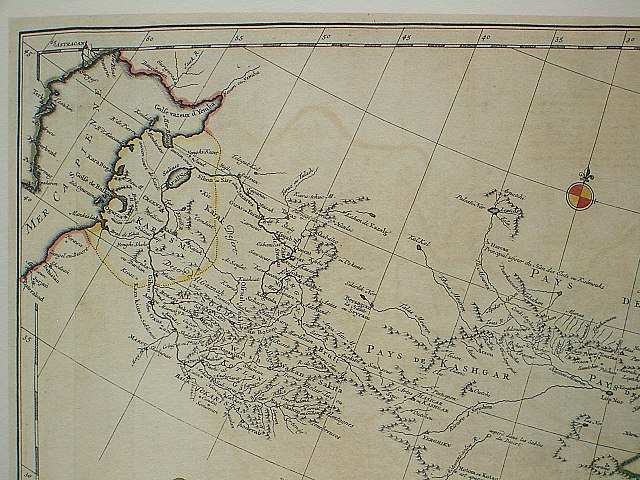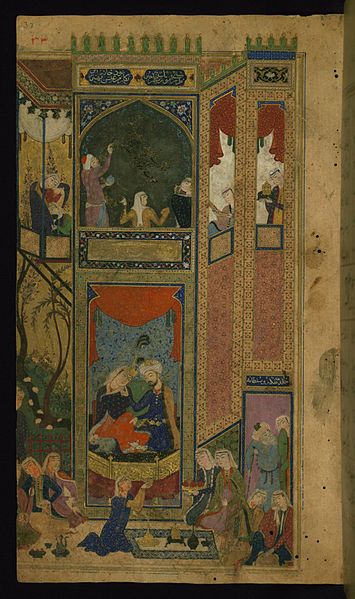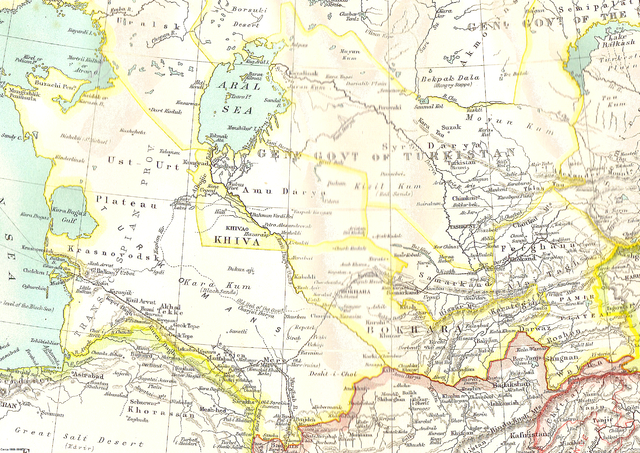
| KHWARAZM
Location of the Khwarazm heartland in Western Asia
The Khwarazm oasis on a satellite image from 2009 Today part of : Uzbekistan, Kazakhstan and Turkmenistan
Khwarazm, or Chorasmia (Old Persian: Uvârazmiya, Persian: Xwârazm or Xârazm), is a large oasis region on the Amu Darya river delta in western Central Asia, bordered on the north by the (former) Aral Sea, on the east by the Kyzylkum desert, on the south by the Karakum desert, and on the west by the Ustyurt Plateau. It was the center of the Iranian Khwarazmian civilization, and a series of kingdoms such as the Khwarazmian dynasty and the Afrighid dynasty, whose capitals were (among others) Kath, Gurganj (the modern Konye-Urgench) and – from the 16th century on – Khiva / Khiv. Today Khwarazm belongs partly to Uzbekistan and partly to Turkmenistan.
Names
and etymology :
In Avestan the name is Xvairizem; in Old Persian u-v-a-r-z-mi-i-š or u-v-a-r-z-mi-i-y (/hUvarazmi-/); in Modern Persian: Xarazm; in Arabic: Xuwarizm; in Modern Chinese Hualázimó; in Tajik: Xorazm; in Kazakh: Xorezm, in Uzbek: Xorazm in Turkmen: Horezm, in Turkish: Harezm; in Greek language Chorasmía and Chorasíma by Herodotus.
Etymology :
Mawara'nnahr, Khwarazm and Greater Khorasan The Arab geographer Yaqut al-Hamawi in his Mugam al-buldan wrote that the name was a Persian compound of khwar, and razm, referring to the abundance of cooked fish as a main diet of the peoples of this area.
C.E. Bosworth, however, believed the Persian name to be made up of xor ("the sun") and zam ("earth, land"), designating "the land from which the sun rises", although a similar etymology is also given for Khurasan. Another view is that the Iranian compound stands for "lowland" from kh(w)ar "low" and zam "land.". Khwarazm is indeed the lowest region in Central Asia (except for the Caspian Sea to the far west), located on the delta of the Amu Darya on the southern shores of the Aral Sea. Various forms of khwar/khar/khor/hor are commonly used also in the Persian Gulf to stand for tidal flats, marshland, or tidal bays (e.g., Khor Musa, Khor Abdallah, Hor al-Azim, Hor al-Himar, etc.)
The name also appears in Achaemenid inscriptions as Huvarazmish, which is declared to be part of the Persian Empire.
Some of the early scholars believed Khwarazm to be what ancient Avestic texts refer to as Airyanem Vaejah (Ariyaneh Waeje; later Middle Persian Iran vij). These sources claim that Old Urgench, which was the capital of ancient Khwarazm for many years, was actually Ourva, the eighth land of Ahura Mazda mentioned in the Pahlavi text of Vendidad. However, Michael Witzel, a researcher in early Indo-European history, believes that Airyanem Vaejah was located in what is now Afghanistan, the northern areas of which were a part of ancient Khwarazm and Greater Khorasan. Others, however, disagree. University of Hawaii historian Elton L. Daniel believes Khwarazm to be the "most likely locale" corresponding to the original home of the Avestan people, and Dehkhoda calls Khwarazm "the cradle of the Aryan tribe".
Legendary
history :
Early people :
Chorasmian frescoe from Kazakly-Yatkan (fortress of Akcha-Khan Kala), 1st century BCE-2nd century CE Like Soghdiana, Khwarazm was an expansion of the BMAC culture during the Bronze Age which later fused with Indo-Iranians during their migrations around 1000 BC. Early Iron Age states arose from this cultural exchange. List of successive cultures in Khwarazm region 3000–500 BC :
•
Keltiminar Culture c. 3000 BC
Khwarezmian
language and culture :
Chilpyk Zoroastrian Tower of Silence (Dakhma), 1st century BCE - 1st century CE In the very early part of its history, the inhabitants of the area were from Iranian stock and they spoke an Eastern Iranian language called Khwarezmian. The famous scientist Al-Biruni, a Khwarezm native, in his Athar ul-Baqiyah, specifically verifies the Iranian origins of Khwarezmians when he wrote (in Arabic):
("The people of the Khwarezm were a branch from Persian tree.")
The area of Khwarezm was under Afrighid and then Samanid control until the 10th century before it was conquered by the Ghaznavids. The Iranian Khwarezmian language and culture felt the pressure of Turkic infiltration from northern Khwarezm southwards, leading to the disappearance of the original Iranian character of the province and its complete Turkicisation today, but Khwarezmian speech probably lasted in upper Khwarezm, the region round Hazarasp, till the end of the 8th/14th century.
The Khwarezmian language survived for several centuries after Islam until the Turkification of the region, and so must some at least of the culture and lore of ancient Khwarezm, for it is hard to see the commanding figure of Al-Biruni, a repository of so much knowledge, appearing in a cultural vacuum.
Achaemenid period :
Xerxes I tomb, Choresmian soldier circa 470 BCE The Achaemenid Empire took control of Chorasmia possibly during the reign of Cyrus the Great in the 6th century, and certainly by the time of King Darius I (ruled 550–486 BCE). The son of Cyrus Smerdis/Bardiya became the governor of the region, along with Bactriana, Carmania, and the other eastern provinces of the empire. And the Persian poet Ferdowsi mentions Persian cities like Afrasiab and Chach in abundance in his epic Shahnama. The contact with the Achaemenid Empire had a great influence on the material culture of Chorasmia, starting a period of rich economic and cultural development.
Chorasmian troops participated in the Second Persian invasion of Greece by Xerxes in the 480 BCE, under the command of Achaemenid general and later satrap Artabazos I of Phrygia. By the time of the Persian king Darius III, Khwarazm had already become an independent kingdom.
Hellenistic period :
Artav (Artabanos), ruler of Khwarezm. Nike crowning the bust of the ruler. Chorasmian tamgha. Circa 1st - 2nd century CE Chorasmia (Khwarazm) was involved in the conquests of Alexander the Great in Central Asia. When the king of Khwarezm offered friendship to Alexander the Great in 328 BCE, Alexander's Greek and Roman biographers imagined the nomad king of a desert waste, but 20th-century Russian archeologists revealed the region as a stable and centralized kingdom, a land of agriculture to the east of the Aral Sea, surrounded by the nomads of Central Asia, protected by its army of mailed horsemen, in the most powerful kingdom northwest of the Amu Darya (the Oxus River of antiquity). The king's emissary offered to lead Alexander's armies against his own enemies, west over the Caspian towards the Black Sea (e.g. Kingdom of Iberia and Colchis). Alexander politely refused.
Khwarezm was largely independent during the Seleucid, Greco-Bactrian and Arsacid dynasties. Numerous fortresses were built, and the Khwarazm oasis has been dubbed the "Fifty fortresses oasis". Chorasmia remained relatively sheltered from the interests of the Seleucid Empire or Greco-Bactria, but various elements of Hellenistic art appear in the ruins of Chorasmian cities, particularly at Akchakhan-Kala, and the influence of the Greco-Buddhist art of Gandhar, reflecting the rise of Kushan Empire, appears at Toprak-Kala. The early rulers of Chorasmia first imitated the coinage of the Greco-Bactrian ruler Eucratides I. Parthian artistic influences have also been described.
From the 1st century BCE, Chorasmia developed original coins inspired from Greco-Bactrian, Parthian, and Indo-Scythian types. Artav (Artabanus), a Chorasmian ruler of the 1st-2nd century CE, whose coins were discovered in the capital city of Toprak-Kala, imitated the type of the Kushan Heraios and were found together with coins of the Kushan rulers Vima Kadphises and Kanishk.
From the 2nd century CE, Chorasmia became part of the vast cultural sphere corresponding to the rise of the Kushan Empire in the east.
Koi Krylgan Kala fortress (4th - 3rd century BCE)
Ayaz Kala 1 fortress (4th - 3rd century BCE)
Toprak-Kala palace city (1st - 2nd century CE)
Fortress of Kyzyl-Kala, partially restored (1st - 4th century CE) Sassanid period :
Location of the main fortresses of the Chorasmian oasis, 4th century BCE-6th century CE Later, Khwarezm and neighboring Bactriana were part of the Sassanid empire during the time of Bahram II (274-293 CE). Yaqut al-Hamawi verifies that Khwarezm was a regional capital of the Sassanid empire. When speaking of the pre-Islamic "khosrau of Khwarezm", the Islamic "amir of Khwarezm", or even the Khwarezmid Empire, sources such as Al-Biruni and Ibn Khordadbeh and others clearly refer to Khwarezm as being part of the Iranian (Persian) empire. The fact that Pahlavi script which was used by the Persian bureaucracy alongside Old Persian, passed into use in Khwarezmia where it served as the first local alphabet about the AD 2nd century, as well as evidence that Khwarezm-Shahs such as Ala al-Din Tekish (1172–1200) issued all their orders (both administrative and public) in Persian language, corroborates Al-Biruni's claims. It was also a vassal kingdom during periods of Kushans, Hephthalites and Gokturks power before the coming of the Arabs.
Afrighids :
Silver bowl from Khwarezm depicting a four-armed goddess seated on a lion, possibly Nana. Dated 658 AD, British Museum. It displays a fusion of Roman-Hellenistic, Indian and Persian cultural influencies Per Al-Biruni, the Afrighids of Kath were a native Khwarezmian Iranian dynasty which ruled as the Shahs of Khwarezm from 305 to 995 CE. At times they were under Sassanian suzerainty.
In 712, Khwarezm was conquered by the Arabian Umayyads. It thus came vaguely under Muslim control, but it was not till the end of the 8th century and the beginning of the 9th century that an Afrighid Shah first converted to Islam appearing with the popular convert's name of Abdallah ('slave of God'). In the course of the 10th century—when some geographers such as Istakhri in his Al-Masalik wa-l-mamalik mention Khwarezm as part of Khorasan and Transoxiania—the local Ma'munids, who were based in Gurganj, on the left bank of the Amu Darya grew in economic and political importance due to trade caravans. In 995, they violently overthrew the Afrighids and themselves assumed the traditional title of Khwarazm-Shah. Briefly, the area was under Samanid suzerainty, before it passed to Mahmud of Ghazni in 1017. From then on, Turko-Mongolian invasions and long rule by Turko-Mongol dynasties supplanted the Iranian character of the region although the title of Khwarezm-Shah was maintained well up to the 13th century.
Ayaz Kala 2 fortress (6th to 8th century CE)
Ossuary Lid, Tok-Kala Necropolis, Alabaster. 7th-8th century CE Khwarezmid Empire :
Khwarezmian Empire
Takash mausoleum in Kunya Urgench, Turkmenistan The date of the founding of the Khwarazmian dynasty remains debatable. During a revolt in 1017, Khwarezmian rebels murdered Abu'l-Abbas Ma'mun and his wife, Hurra-ji, sister of the Ghaznavid sultan Mahmud. In response, Mahmud invaded and occupied the region of Khwarezm, which included Nasa and the ribat of Farawa. As a result, Khwarezm became a province of the Ghaznavid Empire from 1017 to 1034. In 1077, the governorship of the province, which since 1042/1043 belonged to the Seljuqs, fell into the hands of Anush Tigin Gharchai, a former Turkic slave of the Seljuq sultan. In 1141, the Seljuq Sultan Ahmed Sanjar was defeated by the Qara Khitai at the battle of Qatwan, and Anush Tigin's grandson Ala ad-Din Atsiz became a vassal to Yelü Dashi of the Qara Khitan.
Sultan Ahmed Sanjar died in 1156. As the Seljuk state fell into chaos, the Khwarezm-Shahs expanded their territories southward. In 1194, the last Sultan of the Great Seljuq Empire, Toghrul III, was defeated and killed by the Khwarezm ruler Ala ad-Din Tekish, who conquered parts of Khorasan and western Iran. In 1200, Tekish died and was succeeded by his son, Ala ad-Din Muhammad, who initiated a conflict with the Ghurids and was defeated by them at Amu Darya (1204). Following the sack of Khwarizm, Muhammad appealed for aid from his suzerain, the Qara Khitai who sent him an army. With this reinforcement, Muhammad won a victory over the Ghorids at Hezarasp (1204) and forced them out of Khwarizm.
The Khwarezmid Empire ruled over all of Persia in the early 13th century under Shah Ala al-Din Muhammad II (1200–1220). From 1218 to 1220, Genghis Khan conquered Central Asia including the Kara-Khitan Khanate, thus ending the Khwarezmid Empire. Sultan Muhammad died after retreating from the Mongols near the Caspian Sea, while his son Jalal ad-Din, after being defeated by Genghis Khan at the Battle of Indus, sought refuge with the Delhi Sultanate, and was later assassinated after various attempts to defeat the Mongols and the Seljuks.
Khwarezm
during the rule of Qunghrat dynasty (1360 - 1388) :
Turabek khanum mausoleum in Kunya Urgench, Qunghrat dynasty, 1330, Turkmenistan The region of Khwarezm was split between the White Horde and Jagatai Khanate, and its rebuilt capital Gurganj (modern Kunya Urgench, "Old Gorganj" as against the modern city of Urgench some distance away) again became one of the largest and most important trading centers in Central Asia. In the mid-14th century Khwarezm gained independence from the Golden Horde under the Sufid dynasty. However, Timur regarded Khwarezm as a rival to Samarkand, and over the course of 5 campaigns, he destroyed Urganch completely in 1388.
Khwarazm
during the reign Shibanids - Arabshahids :
Khwarezm (Karasm), on a 1734 French map. The Khanate on the map
surrounds the Aral Sea (depicted as much smaller than it actually
was in those days) and includes much of the today's Kazakhstan's
and Turkmenistan's Caspian coast.
Modern
age :
Early in The Great Game, Russian interests in the region collided with those of the British Empire in the First Anglo-Afghan War in 1839.
The Khanate of Khiva was gradually reduced in size from Russian expansion in Turkestan (including Khwarezm) and, in 1873, a peace treaty was signed that established Khiva as a quasi-independent Russian protectorate.
After the Bolshevik seizure of power in the October Revolution, a short-lived Khorezm People's Soviet Republic (later the Khorezm SSR) was created out of the territory of the old Khanate of Khiva, before in 1924 it was finally incorporated into the Soviet Union, with the former Khanate divided between the new Turkmen SSR, Uzbek SSR and Karakalpakstan ASSR (initially part of Kazakh ASSR as Karakalpak Oblast).
The larger historical area of Khwarezm is further divided. Northern Khwarezm became the Uzbek SSR, and in 1925 the western part became the Turkmen SSR. Also, in 1936 northwestern part became Kazakh SSR. Following the collapse of the Soviet Union in 1991, these became Uzbekistan, Turkmenistan and Kazakhstan respectively. Many of the ancient Khwarezmian towns are situated currently in Xorazm Province, Uzbekistan.
Today, the area that was Khwarezm has a mixed population of Uzbeks, Karakalpaks, Turkmens, Tajiks, Tatars, and Kazakhs.[citation needed]
In Persian literature :
Emir Timur and his maiden from Khwarezm Khwarezm and her cities appear in Persian literature in abundance, in both prose and poetry. Dehkhoda for example defines the name Bukhara itself as "full of knowledge", referring to the fact that in antiquity, Bukhara was a scientific and scholarship powerhouse. Rumi verifies this when he praises the city as such.
Other examples illustrate the eminent status of Khwarezmid and Transoxianian cities in Persian literature in the past 1500 years :
The
world of hearts is under his power in the same manner that Oh
land of Khorasan! God has saved you,
The borders of the Russian imperial territories of Khiva, Bukhara and Kokand in the time period of 1902–1903.
The borders of the Russian imperial territories of Khiva, Bukhara and Kokand in the time period of 1902–1903 Notable people :
The following either hail from Khwarezm, or lived and are buried there :
•
Al-Biruni, outstanding scholar
Source :
https://en.wikipedia.org/ |
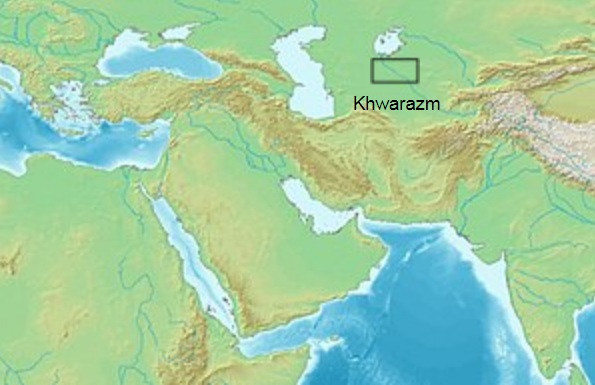
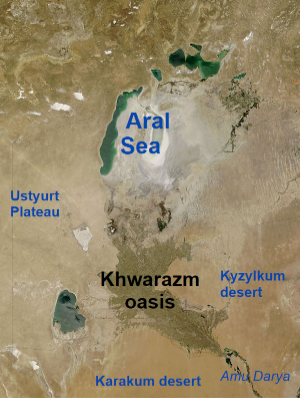
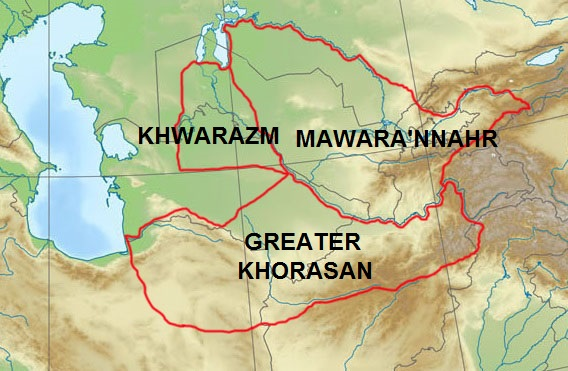
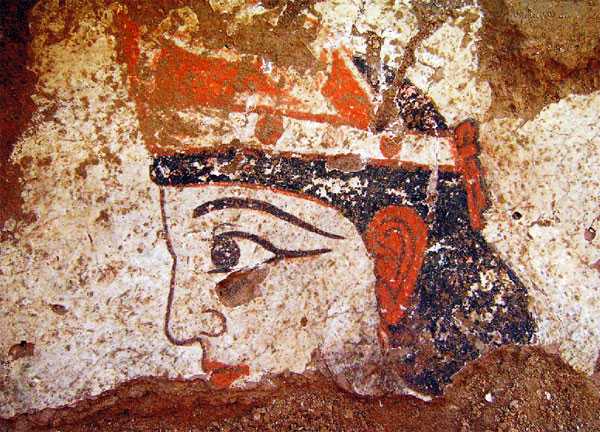
_1st_cent_BCE-1st_cent_CE_Zoroastrian_(4).jpg)
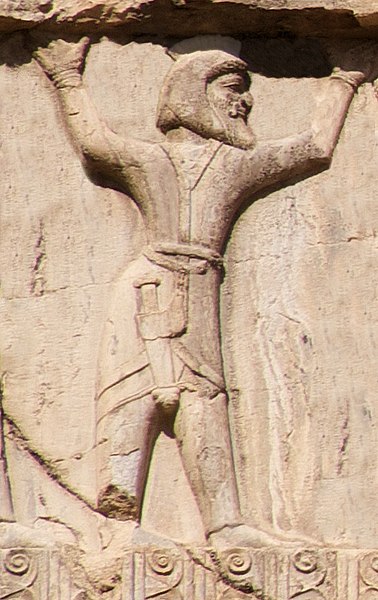
._Circa_1st-2nd_century_CE.jpg)
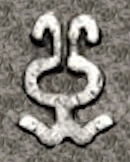
.jpg)
_(5608883427).jpg)
_(5609444698).jpg)
.jpg)
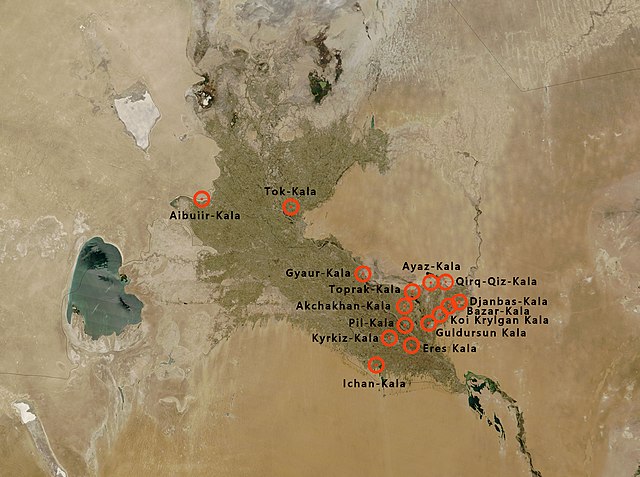
Khwarazm_Bowl_(cropped).jpg)
_(5608879653).jpg)

.png)
